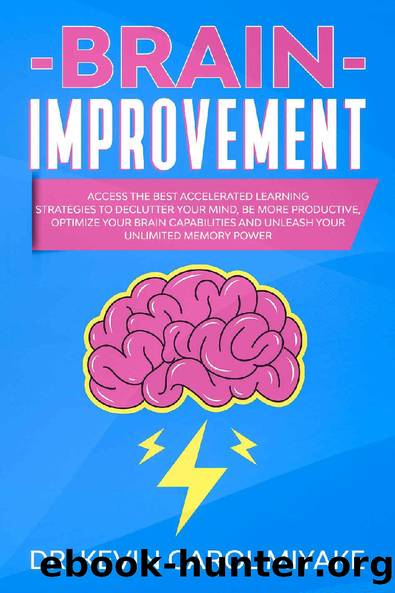Brain Improvement: Access the Best Accelerated Learning Strategies to Declutter Your Mind, Be More Productive, Optimize Your Brain Capabilities and Unleash Your Unlimited Memory Power by Dr. Kevin Carol Miyake

Author:Dr. Kevin Carol Miyake [Miyake, Dr. Kevin Carol]
Language: eng
Format: epub
Published: 2019-11-15T00:00:00+00:00
Chapter 5: The Art of Memory
A Practical Guide to the Processes of Memory
There are three processes that memories go through: encoding, storage, and retrieval. If you observe yourself carefully, you can see these processes in your brain in real time.
Letâs use celebrity names as an example. The name of the hip hop artist Cardi B has probably made its way into your consciousness at some point, whether you are a fan or you barely know who she is.
The more times you heard her name, the more her name was pushed into your memory storage. On a cellular level, the synaptic connections that fired in response to hearing âCardi Bâ fired enough to become a strong connection. When someone asks you to name a modern hip hop artist, you are able to say her name because âCardi Bâ was a fairly strong connection. You can apply these three processes of memory to anything you want to remember or learn.
Knowing the processes that create memories will help you remember pieces of information like names and numbers. There are several learning techniques that will help you do this.
Before we get into techniques for memorizing pieces of information, you might have to readjust the way you think about memory. You might think that you are just âbad at remembering names.â
People say this all the time: âI never forget a face, but Iâm bad with names.â This approach wonât get you anywhere because it is defeatist. If you think you are just bad at remembering names, you wonât learn names. Period. Get past that limiting approach and start being intentional with your memorization.
If you have a roster of studentsâ names to memorize, you canât expect to learn them without devoting time to only learning their names. Put the roster to your left. To your right, copy down their names on notebook paper. It isnât as hard as you think it is. You will probably get them after looking at their faces and writing down their names just three of four times.
You have likely heard of pneumonic devices before. These are an excellent way to remember names.
The thing that keeps a lot of people from using pneumonic device is they are afraid that they are too embarrassing to use. They don't want people to find out about their pneumonic devices.
But if they are really so embarrassing, it doesn't even matter, because you will only keep them in your own head. There is no need to worry about someone finding out. People don't just randomly blurt out random private thoughts like odd pneumonic devices.
Take the names of co-workers, for example. Let's say you meet someone named Robert. You are trying to be more intentional with memorizing names, so you think to yourself: "He acts sort of robotic sometimes, so that will help me remember his name." Or maybe you know someone named David, and you remember his name by the Bible story of David and Goliath. You can remember his name because he is like the smaller David in the story.
Download
This site does not store any files on its server. We only index and link to content provided by other sites. Please contact the content providers to delete copyright contents if any and email us, we'll remove relevant links or contents immediately.
The Science of Rapid Skill Acquisition by Peter Hollins(827)
Memory Builders by Frank MD Minirth(627)
Quantum Memory Power by Dominic O'Brien(606)
Mind Games by Neville Southall(597)
The Victorious Mind: How To Master Memory, Meditation and Mental Well-Being by Anthony Metivier(510)
How to Improve Your Memory and Remember Anything: Flash Cards, Memory Palaces, Mnemonics (50+ Powerful Hacks for Amazing Memory Improvement) (The Learning Development Book Series 7) by John Connelly(508)
The Science of Boredom: Why Boredom Is Good by Sandi Mann(505)
The Super Memory: 3 Memory Books in 1: Photographic Memory, Memory Training and Memory Improvement - How to Increase Memory and Brain Power (Upgrade Yourself) by Zeloni Magelli Edoardo(440)
Brain Improvement: Access the Best Accelerated Learning Strategies to Declutter Your Mind, Be More Productive, Optimize Your Brain Capabilities and Unleash Your Unlimited Memory Power by Dr. Kevin Carol Miyake(411)
Memory Improvement Book - The Mnemonics: Mind and Memory Improvement for Adults (The Active and Effective Leaders 2) by Andrew Kite(403)
Summary of Moonwalking with Einstein by Instaread(386)
Mental Focus and Brain Games For Memory Improvement by Speedy Publishing(382)
10000 Word Scramble Puzzles to Improve Your IQ (IQ BOOST PUZZLES) by Kalman Toth M.A. M.PHIL(350)
